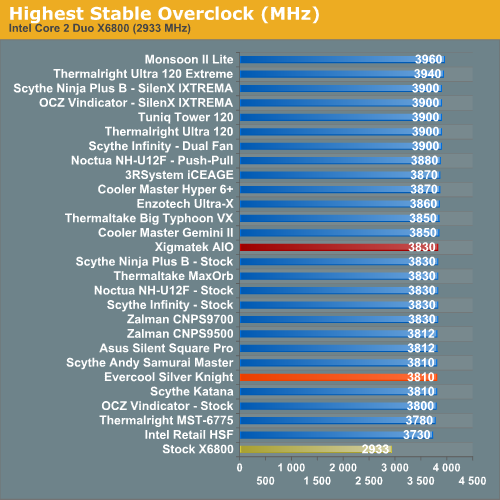Self-Contained Water Coolers: Xigmatek AIO vs. Evercool Silver Knight
by Wesley Fink on July 10, 2007 2:00 AM EST- Posted in
- Cases/Cooling/PSUs
Overclocking
As cooling solutions do a better job of keeping the CPU at a lower temperature, it is reasonable to expect the overclocking capabilities of the CPU will increase. In each test of a cooler we measure the highest stable overclock of a standard X6800 processor under the following conditions:
CPU Multiplier: 14x (Stock 11x)
CPU voltage: 1.5875V
FSB Voltage: 1.30V
Memory Voltage: 2.20V
nForce SPP Voltage: 1.35V
nForce MCP Voltage: 1.7V
HT nForce SPP <-> MCP: Auto
Memory is set to Auto timings on the 680i and memory speed is linked to the FSB for the overclocking tests. This removes memory as any kind of impediment to the maximum stable overclock. Linked settings on the 680i are a 1066FSB to a memory speed of DDR2-800. As the FSB is raised the linked memory speed increases in proportion. The same processor is used in all cooling tests to ensure comparable results.

The Xigmatek AIO reaches a stable 3.83 GHz, which is surprisingly good considering it is based on a small 80mm fan cooling 80mm radiators. The Silver Knight fared worse in overclocking, reaching just 3.81 GHz despite the larger fan, pump, and cooling fin area.
Neither of these results challenges the best air coolers with their 3.90GHz to 3.94GHz overclocks or the TEC/air hybrid Monsoon II at 3.96GHz. It certainly appears the smaller radiators and smaller physical sizes of the self-contained water coolers make it a real challenge to extract top overclocking performance from these coolers. Still, we were impressed with how well the little Xigmatek AIO performed, and we have to wonder how a similar design based on 120mm parts might perform.
As cooling solutions do a better job of keeping the CPU at a lower temperature, it is reasonable to expect the overclocking capabilities of the CPU will increase. In each test of a cooler we measure the highest stable overclock of a standard X6800 processor under the following conditions:
CPU Multiplier: 14x (Stock 11x)
CPU voltage: 1.5875V
FSB Voltage: 1.30V
Memory Voltage: 2.20V
nForce SPP Voltage: 1.35V
nForce MCP Voltage: 1.7V
HT nForce SPP <-> MCP: Auto
Memory is set to Auto timings on the 680i and memory speed is linked to the FSB for the overclocking tests. This removes memory as any kind of impediment to the maximum stable overclock. Linked settings on the 680i are a 1066FSB to a memory speed of DDR2-800. As the FSB is raised the linked memory speed increases in proportion. The same processor is used in all cooling tests to ensure comparable results.

The Xigmatek AIO reaches a stable 3.83 GHz, which is surprisingly good considering it is based on a small 80mm fan cooling 80mm radiators. The Silver Knight fared worse in overclocking, reaching just 3.81 GHz despite the larger fan, pump, and cooling fin area.
Neither of these results challenges the best air coolers with their 3.90GHz to 3.94GHz overclocks or the TEC/air hybrid Monsoon II at 3.96GHz. It certainly appears the smaller radiators and smaller physical sizes of the self-contained water coolers make it a real challenge to extract top overclocking performance from these coolers. Still, we were impressed with how well the little Xigmatek AIO performed, and we have to wonder how a similar design based on 120mm parts might perform.










26 Comments
View All Comments
Spanki - Tuesday, July 10, 2007 - link
Off-topic or not... Woot!! Thanks much - I've always hated those mouse-over links.strikeback03 - Tuesday, July 10, 2007 - link
I never noticed them until I had to visit the site with IE. Guess AdBlock blocks those dumb underlined links too.asliarun - Tuesday, July 10, 2007 - link
Thanks, Anand! This helps a great deal. Sorry if my rant sounded too much like a... rant.tuteja1986 - Tuesday, July 10, 2007 - link
I would like to see thermalright design a cooler like that with better result :) Some has to break the 4Ghz :(Griswold - Tuesday, July 10, 2007 - link
This technique isnt going to take off no matter who makes it because it defeats the purpose of watercooling by design. Just stick to old fashioned aircooling if you want a somewhat space efficient cooling solution.If you want high performance and silence, stick to "real" watercooling with a reasonably sized radiator and fan, not some mini-toy that crams everything in a small box and puts it on top of the CPU like this - and this article proves it.
goinginstyle - Tuesday, July 10, 2007 - link
I think the air cooling reviews are just about played out unless we start seeing AMD results. How well does some of these units already tested work on a 6000+ X2 for example. When will we see reviews with true water cooling setups and products like CoolIt's Freezone? I think a lot people would like to know how well a $100 to $150 water cooling system compares to the top air coolers. How does a custom water cooling solution that might run over $250 work for instance and will your processor do 4.2GHz at acceptable temperature ranges with this type of setup. Otherwise, glad I did not buy one of these self contained hybrid units. It once again appears to be marketing over substance.